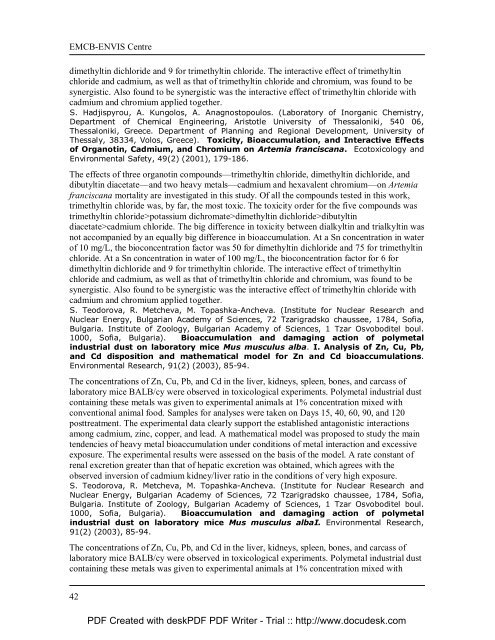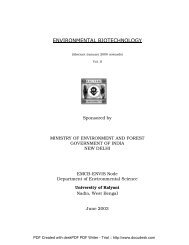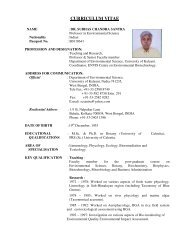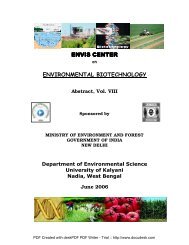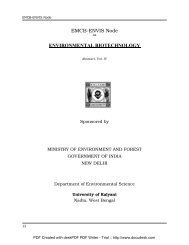EMCB-ENVIS Node ENVIRONMENTAL BIOTECHNOLOGY
EMCB-ENVIS Node ENVIRONMENTAL BIOTECHNOLOGY
EMCB-ENVIS Node ENVIRONMENTAL BIOTECHNOLOGY
Create successful ePaper yourself
Turn your PDF publications into a flip-book with our unique Google optimized e-Paper software.
<strong>EMCB</strong>-<strong>ENVIS</strong> Centre<br />
dimethyltin dichloride and 9 for trimethyltin chloride. The interactive effect of trimethyltin<br />
chloride and cadmium, as well as that of trimethyltin chloride and chromium, was found to be<br />
synergistic. Also found to be synergistic was the interactive effect of trimethyltin chloride with<br />
cadmium and chromium applied together.<br />
S. Hadjispyrou, A. Kungolos, A. Anagnostopoulos. (Laboratory of Inorganic Chemistry,<br />
Department of Chemical Engineering, Aristotle University of Thessaloniki, 540 06,<br />
Thessaloniki, Greece. Department of Planning and Regional Development, University of<br />
Thessaly, 38334, Volos, Greece). Toxicity, Bioaccumulation, and Interactive Effects<br />
of Organotin, Cadmium, and Chromium on Artemia franciscana. Ecotoxicology and<br />
Environmental Safety, 49(2) (2001), 179-186.<br />
The effects of three organotin compounds––trimethyltin chloride, dimethyltin dichloride, and<br />
dibutyltin diacetate––and two heavy metals––cadmium and hexavalent chromium––on Artemia<br />
franciscana mortality are investigated in this study. Of all the compounds tested in this work,<br />
trimethyltin chloride was, by far, the most toxic. The toxicity order for the five compounds was<br />
trimethyltin chloride>potassium dichromate>dimethyltin dichloride>dibutyltin<br />
diacetate>cadmium chloride. The big difference in toxicity between dialkyltin and trialkyltin was<br />
not accompanied by an equally big difference in bioaccumulation. At a Sn concentration in water<br />
of 10 mg/L, the bioconcentration factor was 50 for dimethyltin dichloride and 75 for trimethyltin<br />
chloride. At a Sn concentration in water of 100 mg/L, the bioconcentration factor for 6 for<br />
dimethyltin dichloride and 9 for trimethyltin chloride. The interactive effect of trimethyltin<br />
chloride and cadmium, as well as that of trimethyltin chloride and chromium, was found to be<br />
synergistic. Also found to be synergistic was the interactive effect of trimethyltin chloride with<br />
cadmium and chromium applied together.<br />
S. Teodorova, R. Metcheva, M. Topashka-Ancheva. (Institute for Nuclear Research and<br />
Nuclear Energy, Bulgarian Academy of Sciences, 72 Tzarigradsko chaussee, 1784, Sofia,<br />
Bulgaria. Institute of Zoology, Bulgarian Academy of Sciences, 1 Tzar Osvoboditel boul.<br />
1000, Sofia, Bulgaria). Bioaccumulation and damaging action of polymetal<br />
industrial dust on laboratory mice Mus musculus alba. I. Analysis of Zn, Cu, Pb,<br />
and Cd disposition and mathematical model for Zn and Cd bioaccumulations.<br />
Environmental Research, 91(2) (2003), 85-94.<br />
The concentrations of Zn, Cu, Pb, and Cd in the liver, kidneys, spleen, bones, and carcass of<br />
laboratory mice BALB/cy were observed in toxicological experiments. Polymetal industrial dust<br />
containing these metals was given to experimental animals at 1% concentration mixed with<br />
conventional animal food. Samples for analyses were taken on Days 15, 40, 60, 90, and 120<br />
posttreatment. The experimental data clearly support the established antagonistic interactions<br />
among cadmium, zinc, copper, and lead. A mathematical model was proposed to study the main<br />
tendencies of heavy metal bioaccumulation under conditions of metal interaction and excessive<br />
exposure. The experimental results were assessed on the basis of the model. A rate constant of<br />
renal excretion greater than that of hepatic excretion was obtained, which agrees with the<br />
observed inversion of cadmium kidney/liver ratio in the conditions of very high exposure.<br />
S. Teodorova, R. Metcheva, M. Topashka-Ancheva. (Institute for Nuclear Research and<br />
Nuclear Energy, Bulgarian Academy of Sciences, 72 Tzarigradsko chaussee, 1784, Sofia,<br />
Bulgaria. Institute of Zoology, Bulgarian Academy of Sciences, 1 Tzar Osvoboditel boul.<br />
1000, Sofia, Bulgaria). Bioaccumulation and damaging action of polymetal<br />
industrial dust on laboratory mice Mus musculus albaI. Environmental Research,<br />
91(2) (2003), 85-94.<br />
The concentrations of Zn, Cu, Pb, and Cd in the liver, kidneys, spleen, bones, and carcass of<br />
laboratory mice BALB/cy were observed in toxicological experiments. Polymetal industrial dust<br />
containing these metals was given to experimental animals at 1% concentration mixed with<br />
42<br />
PDF Created with deskPDF PDF Writer - Trial :: http://www.docudesk.com


